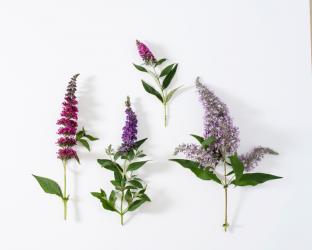This plant has become invasive in parts of the country. Typically, the newer dwarf varieties of the butterfly bush are sterile and not invasive. David Sherwood, Sherwood’s Forest Nursery.
The shrub also attracts bees that pollinate other plants.
They are rabbit-proof and deer-resistant.
Deadhead them for summer-long blooms!
They are magnets for Swallowtail and Monarch butterflies.
In our area, they are very susceptible to crown rot and winter kill. If you trim them too early or too late in the season, it can allow for winter moisture to better access the crown and rot or freeze it. Laura Hill, Frisella Nursery.
Pests & Problems Buddleia are generally free of pests and diseases in the garden. When the plants are stressed by poor conditions, they may be attacked by spider mites. Less frequently, Japanese beetles, caterpillars, weevils or mullein moths may feed on the plants. Scale has also been reported on stressed plants. The best treatment is to hose the plant off with water so you don’t hurt the pollinators (like butterflies and bees) they attract. Keep your butterfly bush well watered and fed to avoid pests. David Sherwood, Sherwood’s Forest Nursery.
Placement is Key Our favorite butterfly magnets, Asclepias incarnata “Swamp Milkweed” and Eupatorium “Baby Joe” Joe pye-weed, tower behind the Buddleia cultivars that grow wide rather than tall such as “Pugster Periwinkle” or “Queen of Hearts.” These chunky, floriferous butterfly bushes will then disguise the mostly leafless, somewhat unattractive stems of these and other tall perennials. Kathie Hoyer, Bowood Farms.
Blooming Most butterfly bushes begin blooming in early summer with blooming continuing all summer. Some begin blooming in mid-summer with blooming continuing into fall. For best blooming results, plant in full sun in soil that has been amended with organic matter. You can fertilize with an all-purpose fertilizer, following manufacturer's instructions. Keep plants well watered, especially when plants are setting up buds and blooming and during dry spells. It’s important to remember that plants need to dry out between watering; too much water will rot the plant's roots. When you do water, water deeply. Ann Lapides, Sugar Creek Gardens.
Mini Match Made in Heaven For smaller, city gardens we suggest homeowners add smaller, tidier cultivars of butterfly favorites such as Echinacea “Mellow Yellow” coneflower, Symphyotrichum “Purple Dome” aster and Rudbeckia “Little Goldstar” black-eyed susan to complement their Buddleia, which attract nectar-seeking butterflies without overwhelming the space—particularly in the fall!Kathie Hoyer, Bowood Farms.







